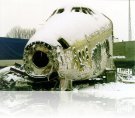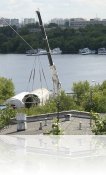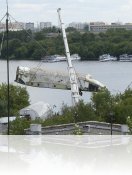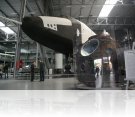Archives for 'Buran'
OK-MT in its sarcophagus
Here are some pictures of the shuttle OK-MT taken at the beginning of August in the MZK building in Baikonur.
This building has been disused since the end of the program (beginning of the 90′s) this is easily noticeable due to the pile of dust on the orbiter.
Posted on:
2011-09-15 under
Baikonur, Buran OK-MT.
2 comments
»
End of restauration ?
The OK-2.01 shuttle was moved few weeks ago from its storage area (Tushino banks) to the Zhukovsky airport to be restored.
This is the first picture of the restoration shoot by Ivan Kirilov, where we can see the work achieved.
Clearly the « restoration » had to be done for the MAKS-2011, because the heat shield was not restored, only a layer of paint was put on the existing tiles. The leading edge and the nose cone are missing, there is not rear view but knowing that the engines weren’t on the model during it’s storage period there is few chance that they put them on the shuttle.
Update 17/08/2011:
Here are 2 new pictures of the MAKS 2011, head side for visitors, reverse side … without comments.
Posted on:
2011-08-16 under
Buran OK-2.01.
1 comment
»
Move of OK-2.01 for the MAKS 2013
The Buran shuttle OK-2.01 was moved yesterday (Wednesday 22) for the MAKS 2013.
It’s in the Tushino region, East of Moscow, that the shuttle has been lying for years, this Buran shuttle of second generation wasn’t finished when the program was stopped in the beginning of the 90′s. Since then Molniya institute has been stocked it on a canal’s wharfage not far from the assembly factory.
On Wednesday 22, June during the day the shuttle was put on a barge to be moved to the MAKS 2013 international air show, which will take place in the Zhukovsky town (Moscow region).
Source: tushino.livejournal.com.
Update:
The shuttle has arrived at Zhukovsky on Monday 27, June.

Posted on:
2011-06-23 under
Buran OK-2.01.
3 comments
»
Videos on the TsAGI test institut
Here is a set of videos published by TV Roscosmos and TsAGI press about the TsAGI test insitute.
This institute is 90 years old and is a necessary step in the validation process of all flying apparatus in the Russian Federation and previously in the USSR.
The development of the Buran shuttle and Energia launch vehicle also needed batch tests in wind tunnels like we can see in the reportings.
TsAGI press:



TV Roscosmos:



Posted on:
2010-11-23 under
Buran, Energia, Web Site.
Commentaires fermés
The last Snowstorm of the Empire
Some days ago TV Roscomos published a reporting about the Buran-Energia program named ПоÑледний « Буран » Империи (The last Snowstorm of the Empire).
It was the most expensive space program of the USSR, but after one successful flight, in automatic regime, the project was grounded and then stopped.
This reporting explains why the Soviets choose to build a shuttle and why it was done this way.

From: TV Roscosmos.
Posted on:
2010-11-11 under
Buran, Energia, Polyus.
Commentaires fermés
Visit of the aviation and cosmonautic museum of Moscow
Back from my little trip in Russia I publish pictures of the space museums I visited. Here, it’s the museum of aviation and cosmonautic which is located in Moscow not far from the former airport.
Other museum’s pictures will come.
Here begin the visit.
Posted on:
2010-08-31 under
Baikonur, Buran, Energia, Museum.
2 comments
»
Roscomos will not revive Buran
 |
 |
During a meeting for the inauguration of a school, director of Roscomos, A.N. Perminov confirmed that there is no plans to revive the Buran project, nor develop a reusable system, at least like the Buran/Shuttle.
In accordance to the president of Roscosmos there is no plan to develop a reusable transport system even if the idea is interesting and it is necessary to continue researches in this field. But the way it was done on Buran and on the American Shuttle is detrimental because it implies important using costs and it is not secure.
The main point is the economical aspect, the cost of a launch of the American Shuttle is up to 0.5 billion of dollars, this is a lot of money even for a country like the United States.
The second point is about security, this spacecraft is not reliable at 100%, two accidents on the Shuttle showed it. Despite the hight level of design of Buran and the Shuttle, this is the same for Buran. This way has no advantage and is hazardous.
Ещё на один Ð²Ð¾Ð¿Ñ€Ð¾Ñ Ð¾Ñ‚Ð²ÐµÑ‚Ð¸Ð» Ð.Ð. Перминов – о «Буране»: «Ðет ли ÑÐµÐ³Ð¾Ð´Ð½Ñ Ð¿Ð»Ð°Ð½Ð¾Ð² Ð²Ð¾Ð·Ñ€Ð¾Ð¶Ð´ÐµÐ½Ð¸Ñ Ñтого проекта или каких-то других проектов ÑÐ¾Ð·Ð´Ð°Ð½Ð¸Ñ Ð¼Ð½Ð¾Ð³Ð¾Ñ€Ð°Ð·Ð¾Ð²Ñ‹Ñ… пилотируемых коÑмичеÑких кораблей?»
«Ðе хотелоÑÑŒ Ð²Ð°Ñ Ð¾Ð³Ð¾Ñ€Ñ‡Ð°Ñ‚ÑŒ, но лучше Ñразу Ñказать: нет, не планируем. Ð˜Ð´ÐµÑ ÑÐ¾Ð·Ð´Ð°Ð½Ð¸Ñ Ð¼Ð½Ð¾Ð³Ð¾Ñ€Ð°Ð·Ð¾Ð²Ñ‹Ñ… коÑмичеÑких кораблей Ñама по Ñебе Ñ…Ð¾Ñ€Ð¾ÑˆÐ°Ñ Ð¸ будет иÑпользована дальше однозначно. Ðо как она была иÑполнена и на «Буране», и на американÑких шаттлах, она оказалаÑÑŒ невыгодной из-за выÑокой ÑтоимоÑти обÑÐ»ÑƒÐ¶Ð¸Ð²Ð°Ð½Ð¸Ñ Ð¸ ненадёжноÑти.
Во-первых: ÑкономичеÑкий аÑпект. СтоимоÑÑ‚ÑŒ запуÑка одного шаттла обходитÑÑ ÐÐСРдо 0,5 млрд долларов. Ðто очень много даже Ð´Ð»Ñ Ñ‚Ð°ÐºÐ¾Ð¹ Ñтраны, как Ðмерика.
Во-вторых: надёжноÑÑ‚ÑŒ. Пока ещё не обеÑпечена 100-Ð¿Ñ€Ð¾Ñ†ÐµÐ½Ñ‚Ð½Ð°Ñ Ð½Ð°Ð´Ñ‘Ð¶Ð½Ð¾ÑÑ‚ÑŒ кораблей многоразового иÑпользованиÑ, и 2 ÑÐ»ÑƒÑ‡Ð°Ñ ÐºÐ°Ñ‚Ð°Ñтроф Ñ ÑˆÐ°Ñ‚Ñ‚Ð»Ð°Ð¼Ð¸ тому ÑвидетельÑтво. ÐеÑÐ¼Ð¾Ñ‚Ñ€Ñ Ð½Ð° Ð¾Ñ‚Ð»Ð¸Ñ‡Ð¸Ñ Ð² Ñхеме компоновки «Бурана» и шаттлов, вÑÑ‘ оÑтальное на «Буране» то же Ñамое – те же недоÑтатки. Ðто направление оказалоÑÑŒ невыгодным и опаÑным.
Posted on:
2010-07-07 under
Buran, Energia.
3 comments
»
Igor Volk at Speyer
Igor Volk (tests pilots chief of the Buran program) was at the Speyer museum (Germany) on last 8th May to receive the TM-19 Soyuz capsule and attend an autograph show in the new space building.
Pictures: Nicolas Pillet.
Posted on:
2010-05-10 under
Buran OK-GLI.
2 comments
»












